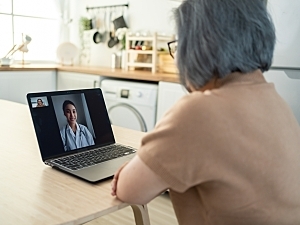The COVID-19 pandemic has accelerated use of telehealth, but there’s been concern about whether surgical specialties can deliver adequate care in this manner.
Quoc-Dien Trinh, MD, MBA, director of ambulatory clinical operations in the Department of Urology at Brigham and Women’s Hospital, Maheetha Bharadwaj, MS, formerly of the Division of Urological Surgery, and colleagues have found that usage of telehealth varied by surgical specialty during the pandemic. Their report in Telemedicine and e-Health also supports previous data on socioeconomic disparities in telemedicine uptake during COVID-19.
Methods
The researchers analyzed 123,075 surgical outpatient visits at Mass General Brigham across five 3-month periods:
- Pre-pandemic 1—March 2 to June 2, 2019 (n=27,959)
- Pre-pandemic 2—December 1, 2019, to March 1, 2020 (n=26,104)
- Pandemic 1—March 2 to June 2, 2020 (n=14,736)
- Pandemic 2—June 3 to September 3, 2020 (n=25,501)
- Pandemic 3—September 4 to December 4, 2020 (n=28,725)
Uptake of Telemedicine
The proportion of virtual visits increased substantially from the pre-pandemic to pandemic periods:
- Pre-pandemic 1—0.85% of visits were virtual
- Pre-pandemic 2—1.1%
- Pandemic 1—47.6%
- Pandemic 2—29.9%
- Pandemic 3—23.5%
Certain socioeconomic factors affected the trends:
- From Pre-pandemic 2 to Pandemic 2—9.5% less increase in telehealth usage for non-English speakers than for English speakers (P< 0.01) and 3.8% less for Medicare beneficiaries than for non-Medicare beneficiaries (P<0.05)
- From Pre-pandemic 2 to Pandemic 3—6.8% less increase in telehealth usage for non-English speakers than for English speakers (P< 0.01) and 2.7% less for Medicare beneficiaries than for non-Medicare beneficiaries (P<0.05)
For Black and white patients, rates of increase in telehealth usage between the Pre-pandemic and Pandemic periods were similar.
Uptake of Phone Visits
From Pre-pandemic 2 to Pandemic 3, certain groups were more likely to have an increase in telephone-based visits compared with video-based visits:
- Black patients—14.7% greater increase compared with white patients (P<0.01)
- Non-English speakers—22.2% greater increase compared with English speakers (P<0.01)
- Medicare beneficiaries—8.5% greater increase compared with non-Medicare beneficiaries (P<0.05)
Uptake of Telemedicine by Surgical Specialty
The increase in urology telehealth visits was 12% higher than the growth in other surgical specialties between the Pre-pandemic and Pandemic periods, and for general surgery the uptake was 12% to 15% higher.
The uptake of telehealth visits in plastic surgery, otolaryngology, and breast surgery was more than 10% lower than in other surgical subspecialties.
Call for Action by Healthcare Administrators
The Centers for Medicare & Medicaid Services is considering whether to eliminate coverage for telephone visits, which would put telehealth access for marginalized communities at risk. Policy changes and interventions are necessary to promote a more unbiased expansion of telehealth and reduce disparities in access to care, particularly during public health emergencies.
